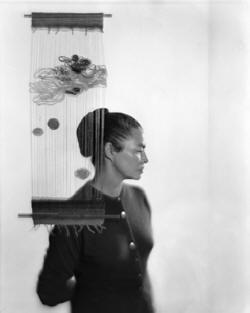

Queer Places:
115 Spring St, New York, NY 10012
Woodlawn Cemetery
Urbana, Champaign County, Illinois, USA
 Lenore Tawney (born Leonora Agnes Gallagher; May 10, 1907 – September 24, 2007) was an American artist known for her drawings, personal collages, and sculptural assemblages, who became an influential figure in the development of fiber art.[1]
The Coenties Slip was a haven for the queer community in the 1960s. It is
speculated that Agnes Martin was
romantically involved with Lenore Tawney during this time.] A pioneer of her time, Agnes Martin never publicly expressed her sexuality, but has been described as a "closeted homosexual." The 2018 biography Agnes Martin: Pioneer, Painter, Icon describes several romantic relationships between Martin and other women, including the dealer
Betty Parsons.
Lenore Tawney (born Leonora Agnes Gallagher; May 10, 1907 – September 24, 2007) was an American artist known for her drawings, personal collages, and sculptural assemblages, who became an influential figure in the development of fiber art.[1]
The Coenties Slip was a haven for the queer community in the 1960s. It is
speculated that Agnes Martin was
romantically involved with Lenore Tawney during this time.] A pioneer of her time, Agnes Martin never publicly expressed her sexuality, but has been described as a "closeted homosexual." The 2018 biography Agnes Martin: Pioneer, Painter, Icon describes several romantic relationships between Martin and other women, including the dealer
Betty Parsons.
Leonora Agnes Gallagher was one of five children born in Lorain, Ohio to Irish American parents Sarah Jennings and William Gallagher.[2] She left home at age 20 and worked in Chicago as a proofreader while taking night courses at the Art Institute of Chicago.[3] In 1941 she married George Tawney, who died eighteen months later.[2] After his death, she to moved to Urbana, Illinois to be near his family and enrolled at the University of Illinois to study art therapy.[4] Tawney's introduction to the tenets of the German Bauhaus school and the artistic avant-garde began in 1946 when she attended László Moholy-Nagy's Chicago Institute of Design. There she studied with cubist sculptor Alexander Archipenko and abstract expressionist painter Emerson Woelffer, among others, and in 1949, she studied weaving with Marli Ehrman.[5] While living in Paris from 1949-1951, she traveled extensively throughout North Africa and Europe.[2] In 1954, she studied with the distinguished Finnish weaver Martta Taipale at Penland School of Crafts and began working tapestry and introduced a new palette into her work.[4]
In 1957, she moved to New York City, where she became associated with a generation of Minimalist artists including Ellsworth Kelly, Robert Indiana, Agnes Martin and Jack Youngerman. In 1961, Tawney's first solo exhibition, which included forty weavings she had produced since 1955, opened at the Staten Island Museum[2] That year, she also pioneered an "open reed" for her loom in order to produce more mutable woven forms.[2] Throughout the 1960s Tawney created drawings, postcard collages, and college and box forms and she combined collage and woven works.[6] After 1977 she "...developed a series of architecturally scaled 'clouds', composed of thousands of shimmering linen threads suspended from canvas supports..."[7] From the late 1950s up until her death in 2007, Tawney lived and worked mainly in New York City, traveling abroad frequently. "The first hundred years", she said with a smile on her hundredth birthday, "were the hardest."[8] Widely known in the New York art world and beyond, she was the veteran of more than two dozen solo exhibitions in leading galleries and museums and she participated in dozens of important group exhibitions. The American Craft Museum (New York City), the Art Institute of Chicago, the Cleveland Museum of Art, the Honolulu Museum of Art, the Metropolitan Museum of Art, the Neuberger Museum of Art (Purchase, New York), the Renwick Gallery (Washington, D.C.), and the Stedelijk Museum Amsterdam are among the Tawney public collections. Lenore Tawney: A Retrospective: American Craft Museum was published in 1990 by Rizzoli, and Lenore Tawney: Signs on the Wind, Postcard Collages was published by Pomegranate in 2002.[9]
My published books: